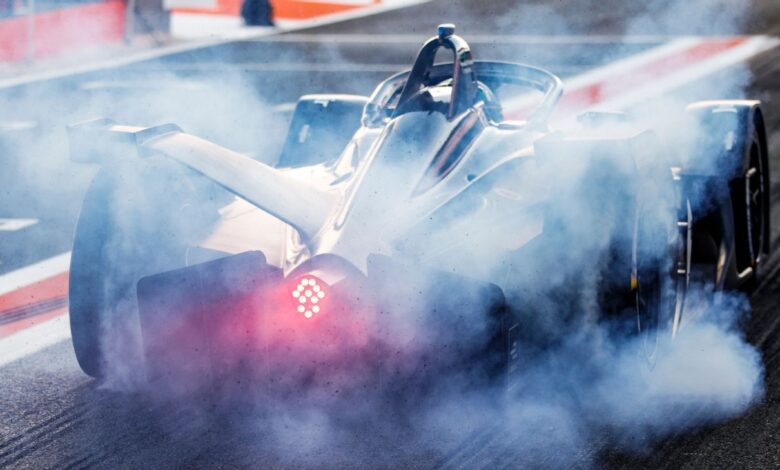What’s next for Formula E heading into season eight?

When Formula E returned to the streets of London in 2021 for the first time since 2015, it did so against a poignant backdrop. “Race against climate change” is the message on one of the team’s cars and the all-electric series set out as a high performance driver for manufacturers in the electric vehicle (EV) market.
When I sat down with Formula E CEO Jamie Reigle the distinctive hum of electric cars lapping in and out of London’s ExCel centre could be heard in the background, while torrential rain flooded the U.K. capital. By the time the race wrapped up on Sunday evening, with cars and pit garages packed up into shipping containers, one of London’s (electric) DLR stations just three miles down the road, Pudding Mill Lane, was underwater. The videos, broadcast on national news, left an uncomfortable aftertaste for the weekend in proving that climate change is here to stay no matter who is racing against it.
Formula E embarks on its eighth season opening in Saudi Arabia on Saturday. The series has reached maturity and gained FIA World Championship status but a murky future lies ahead as the series must decide what it wants to be, while manufacturers weather a troublesome storm in the world’s race for a green, low carbon future.
“We started as a vision of accelerating electric mobility in simple terms,” Reigle tells ESPN. “And we’re the only sport that’s founded with that sense of purpose … we’re using sport to inspire and tell stories around climate change, and all that good stuff. But the practical reality is we’re at a maturity level now seven seasons in, we have to build a credible tier one-sport.
“In 2014, when we started the business, the world wasn’t looking for another motorsport. Most of those rounds were pretty well served. Equally, the world probably wasn’t looking for another advocacy group. The magic is bringing them together in one kind of mix.”
In the founding years, EVs began to take off (Tesla was listed on NASDAQ in 2010) and founder Alejandro Agag believed there was a gap in demonstrating that electric cars could be high performance and exciting.
“And then you had the regulatory side as well,” Reigle says. “Where the European Union in particular and governments around the world were starting to say ‘ok, we’re going to have to curb emissions’.”
In order to excel, Formula E needed to be something different, disruptive, unique.
The questions at the beginning were often over the unusual high-pitched hiss of the cars, since motor racing fans are known to love the growl of a loud engine.
“That’s the point. Right?” Reigle says. “I’m walking in this morning, you can hear practice, and it’s so unique. It’s a brand identity. I think we were a bit overly apologetic about it. Because a lot of our early teams — German manufacturers, French manufacturers, they come from motorsport so they’re like, ‘Oh, I want to have the smells and the sounds that I associate with’. But the whole point is, we’re something different which is why we come here, and we can race in the ExCel because you wouldn’t be able to do that if you had really loud [and polluting] engines.”
He goes on to add that older generations associate cars with internal combustion engines. Children growing up won’t believe that “the prism of a car should sound really loud.”
The Diriyah double-header in Saudi Arabia this weekend marks the start of the last season with the “Gen2” cars – although they do have upgrades with increased peak power, 250kW compared to 235kW – before fresh technology including new batteries and enhanced drivetrains come in for the 2022/2023 season.
However, the upgrades come against a background of three huge brands withdrawing from the sport. Audi, who were a works team and supplier, left at the end of the 2020-2021 season, followed by BMW who were the title sponsor of Andretti; while Mercedes, who won the title in their inaugural season in 2021, will leave once the upcoming season concludes.
Audi, who joined the sport early on, said it was changing its focus to take on the Dakar Rally and become the first manufacturer to win with an electric drivetrain. (It finished ninth overall, with four stage wins and all three cars finishing on its first attempt earlier this year).
Although the withdrawals are a blow to the series, all three manufacturers reported their departures were due to exhausting their development of EV technology and drivetrains, using the learnings in their road cars, as well as diverting their finances. Their development will continue behind the scenes but the marketing involved in winning races ceases.
Similarly, Mercedes said it would concentrate on Formula One, while shifting resources to its goal of being fully electric by the end of the decade using its learnings. Meanwhile Maserati announced they will be entering the series from 2023, and Jaguar extended their long-term commitment.
Aside from Maserati and Jaguar, Reigle admits the loss is disappointing: “I mean, I can’t hide from that … I can’t really speak for the individual decisions they’ve made, but I would say a couple things.”
One of the points he explains relates to the timing of the decisions, made when the coronavirus pandemic was at its peak in ripping global economies to shreds in 2020. Stock markets crashed, production lines ground to a halt and cars were not being sold or produced. Automotive was one of the hardest hit industries with a complete supply chain meltdown, and still in 2022, the effects of a lack of microchips (a car uses over 3000) and supply chain backlogs as well as inflation are being grimly felt.
Audi, though, spoke fondly of Formula E and described its time in the sport as having been crucial to its road car development, as well as being good marketing. After almost seven years, they decided to try something new.
Daniel Schuster, chief press officer at Audi, told ESPN: “Not only in terms of hardware because that’s the easy part but what changed completely [is] the efficiency and the knowledge, how you use the electric package and optimise it. These are the factors that go straight away into the road car business and where our customer can benefit.
“From our perspective, as a manufacturer, you’re the first to have all the knowledge by building the car and all the things how you use it, how you develop the software, recuperation and energy management, this is something we can learn a lot and bring something into the road car business.
He adds: “In motorsport, there’s a lot of change at the moment, everybody’s discussing electrification but Formula E is the only real championship that is really electric and uses all the potential to rethink strategies and everything around the racing. They really created a completely new kind of racing series, in the cities, different target groups, and different formats.
“The beauty about Formula E is racing in a city centre, getting target groups to the racing that are completely independent from racing. When we’re standing in front of the garage giving garage tours, I would say 90% had never ever followed a race on a track, maybe on TV. The target groups you reach in Formula E is different, and maybe closer to the road car customer we do have, and further away from the racing fans.”
Reigle also says, following the departures, Formula E reviewed the road map to “create conditions for the best drivers and teams to emerge” to build a long-term franchise value. The changes include a cost cap.
“It’s about looking at existing manufacturers who are shifting and having some conversations with new entrants, who are looking at going fully electric and who might see us as a way to accelerate that growth.
“You probably wouldn’t be surprised to hear that German manufacturers were spending more than the average. The cost cap was partially in response to [the spending], not in response to their exit.”
Reigle, a Canadian businessman formerly a senior executive at Manchester United, moves on to discuss how continuity of teams and exciting, competitive racing where no team dominates can help “short circuit” some of the historic prestige that the series lacks compared to, for example, Manchester United’s (nearly) 150-year history and F1’s 70 years.
“It’s in our interest that the teams have a profitable business model. Because if your teams aren’t making money or your manufacturers don’t see a return on investment, or sponsors think it doesn’t make sense. You can survive for a little while, but eventually, you face some challenges.
“We want to build long term franchise value. And in that, all things being equal attracts investors. It also attracts fans, because you have continuity of the team, so you can build that fandom over time.”
Each generation of car has had major upgrades. The Gen1 batteries could not last a full race and drivers would have to strategically swap cars in the pits partway through. Gen2 are more powerful and longer lasting, with races often decided by superb energy conservation, and leaders delicately nursing their 1% charge to the chequered flag like a millennial anxiously sending a final text with the drying juices of an iPhone battery.
“One of the inhibitors or reasons you might not buy an electric car is how long is the charge going to last, what’s the range, etc,” Reigle says. “So we think the fast charging element, which is part of our road map, is really important.
“In Gen3, we’re looking at how we can extend the length of the race and the duration, undercut fast charging, which also allows us to showcase in simple terms the concept of how we’re going from here [London] to Newcastle [285 miles away] or whatever. You’d be able to pull into a service station, charge for a couple minutes and carry on. Right, so that’s the roadmap, and that takes us into like the late 2020s in order to still be relevant in 2035.”
Two things need to happen, he explains: “We need to continue on the development path and maybe whatever that looks like, I mentioned the battery before … And then we have to make it a compelling sporting proposition. People want to come watch, because the racing is exciting.
“My contention is, it’s on us to make sure our championship is a compelling product. Formula E must have to have a purpose that goes beyond just showcasing electric cars.”
Which is apt, because electric cars may not live up to the green future that has been spun.
Batteries require lithium, nickel, cobalt, copper, and other materials to be mined, with 60% of the world’s lithium reserves coming from China, and 70% of cobalt mined in Congo. The Financial Times reported the demand for lithium is forecast to grow up to 4,000% by 2040, with the typical EV battery containing about 8kg worth.
Prices of the raw material soared 240% in 2021 as supply struggled to match demand and nickel rose by 12% in December alone to a 10-year high. In addition, mining involves widespread fossil fuel usage before the raw material has even reached an automotive factory. The entire process sharply reduces the long-term sustainability of the goal of an electric car future.
Despite inflated prices, one in four new car sales in the UK is an EV. But concerns remain over the environmental cost of producing materials in the high quantities demanded, as well as disposing of the batteries when they are no longer useable — although Volkswagen has come up with a pilot solution for recycling and separating the used raw materials.
However, that does not relate to Formula E as a sport directly. Although their cars may use clean energy, like many sports, shipping and flying around the world has a large carbon footprint, with football one of the largest.
Referencing climate change in their strategy means they are held to account at a higher level. Since the beginning, Formula E has tracked their footprint down to every individual flight and taxi journey. Despite the utmost effort to keep emissions to a minimum, such as no single-use plastics, chartered flights, shipping more efficiently, races in city centres which are accessible by public transport for fans, the number cannot be zero and it wouldn’t be for any sport. The rest is offset.
“We invest in a clean energy project in that market. So that can be like a biomass plant, it could be like a wind farm, or anything that has a lasting impact.”
For Formula E to continue its upward trajectory and aim to be a tier one sport, it must neutralise a bitter taste left by the floods that surround it and move beyond showcasing electric cars and more into sports entertainment as an ever growing electric industry morphs into a different shape.
“We think the journey is worth it,” Reigle says.




